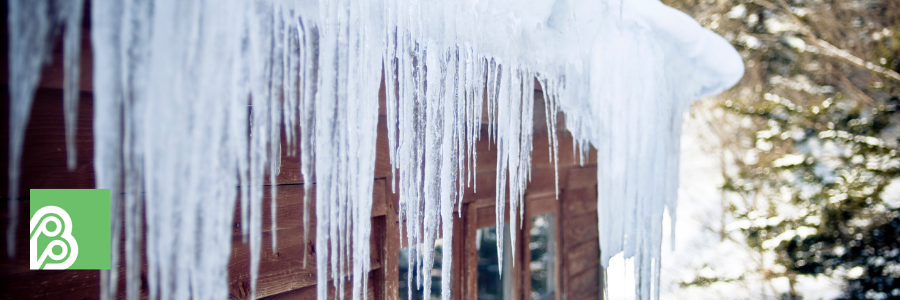Are Ice Dams Covered by Homeowners Insurance?
As I am writing this, it is a 70-degree fall day and just a week ago there was a blanket of snow on the ground. But what do you expect? This is New England.
Which means soon enough, there will be more icy, snowy weather.
And just as we never know what to expect with the weather, we also never know what kind of damage this weather can cause to our homes.
One of these issues, ice dams, are a common occurrence that can cause serious damage to your home.
We know first hand. At Berry Insurance, we’ve dealt with hundreds of ice dam claims and have learned a lot along the way that we can pass on to readers like you!
So let’s get into what ice dams are, what damage is covered, and how they can be prevented or managed.
What are ice dams?
An ice dam is an ice buildup forming at the edge of a roof, preventing snow and water from eventually draining off one’s roof.
Ice dams are ultimately caused by a mix in temperatures. When indoor heating rises into the attic through the ceiling, it begins to warm the roof's surface. Snow located on the heated section of the roof (top and middle) then begins to slide down. The edge of the roof will likely still be frozen due to the non-exposure to the heat – leaving the melting area trapped behind this chunk of ice. This melted puddle partially refreezes as it moves away from the heated area, leading to the dams’ growth.
Ice dams do melt and go away on their own eventually, but while they are present, they can leak into the home, causing damage to your roofing, walls, insulation, flooring, and more.
Are ice dams covered by homeowners insurance?
Yes and no.
Ice dam damage to your roof and gutters are typically covered by your Massachusetts homeowners insurance policy.
However, depending on how the policy is written and which endorsements are included, damage to your personal property caused by an ice dam may or may not be covered. Services to remove ice dams are not covered.
Check with your insurance agent to confirm what is covered for you specifically.
How does an ice dam claim work?
If you have damage from an ice dam, you should document and photograph any damage.
Then, reach out to your insurance agent who can help you file a claim.
Within 24 to 48 hours of filing the claim, an appraiser assigned by your insurance company will contact you to schedule a good time to assess the damage.
Once the damage is assessed, you will be issued two sets of payment for the damage. The first check will be for the actual cash value of the damage reported. That check will likely not be enough to cover all the damage because it includes a “hold back”. A hold back is essentially the difference between the actual cash value of the damage and the replacement cost of the damage. Once the damage to your home has been repaired you’ll be paid the hold back amount.
If you’re not happy with the settlement that you’ve received from the insurance company – you can then contact the claims adjuster to negotiate your settlement amount. Before contacting the adjuster, you’ll want to have a contractors estimate for the entire cost of the damage.
to learn more about the claims process, read our guide when you should file a homeowners insurance claim.
How can I prevent/remove ice dams?
If you live or have a business in Massachusetts, I’m sure you already have a winter weather protection process, but don’t forget about ice dams! Preventing or resolving them will ensure you don’t have to deal with any damage.
Preventing ice dams:
It’s no secret that the best way to avoid ice dam claims is by preventing ice dams in the first place.
While snow and icy weather is occurring, be sure to watch your roof and gutters for any signs of accumulating water or ice dams forming. Clear snow from your roof and correct any blockages causing water to accumulate to prevent damage.
Even dry, fluffy snow can absorb additional sleet and rain and harden, so it should be cleared off if possible.
Keeping heat out of the attic by properly insulating the attic floor and fixing air leaks will also help prevent ice dams.
Removing ice dams:
If you notice you already have an ice dam, you should remove it as soon as possible.
Using calcium chloride ice melter is the most effective way to clear an ice dam. One easy trick is to fill a pair of nylons with calcium chloride ice melter. Lay the nylons along the ice dam, ensuring it hangs over the gutter. The calcium chloride will gradually melt the snow, creating a channel for water to escape through. Be sure to never use rock salt or sodium chloride, as these will damage your roof. We also don't recommend you use a roof rake to break off the ice, as it could cause more damage to your roof.
For more on how you can best defend against wintery home insurance claims, read this article: Avoiding Common Winter Home Insurance Claims.
Prepare for winter weather:
Preparing for winter weather means more than just getting supplies ready and weather-proofing your home.
It also means checking your home insurance policy to make sure you have the proper coverages in place to protect you from any potential winter disasters.
Reach out to your insurance agent so they can help you make sure you have everything you need.
While you’re at it, it might be a good time to review all of your personal insurance coverages to make sure everything is up-to-date and you are covered from any other unexpected scenarios.


.jpg)